Podcast
Questions and Answers
What is a requirement for the opening or connection between the boiler and any safety valve or safety relief valve?
What is a requirement for the opening or connection between the boiler and any safety valve or safety relief valve?
- It must have at least the same cross-sectional flow area of the valve inlet. (correct)
- It must have three times the cross-sectional flow area of the valve inlet.
- It must have twice the cross-sectional flow area of the valve inlet.
- It must have at least half the cross-sectional flow area of the valve inlet.
Why may a flexible joint be necessary near the safety valve in a long vertical discharge pipe?
Why may a flexible joint be necessary near the safety valve in a long vertical discharge pipe?
- To decrease the pressure of the discharge pipe.
- To reduce the flow rate of the discharge pipe.
- To increase the flow rate of the discharge pipe.
- To accommodate the expansion of the discharge pipe and avoid stressing the safety valve. (correct)
Where should the safety valve be located in a low-pressure steam heating boiler?
Where should the safety valve be located in a low-pressure steam heating boiler?
- Below the normal operating water level.
- Anywhere in the boiler.
- Above the normal operating water level. (correct)
- At the normal operating water level.
What is a characteristic of a safety valve especially designed for low-pressure steam heating boilers?
What is a characteristic of a safety valve especially designed for low-pressure steam heating boilers?
How do low-pressure safety valves differ from high-pressure safety valves of the same capacity?
How do low-pressure safety valves differ from high-pressure safety valves of the same capacity?
What is a requirement for safety relief valves according to ASME BPVC IV, Part HG-400.2?
What is a requirement for safety relief valves according to ASME BPVC IV, Part HG-400.2?
What is a characteristic of safety relief valves when tested by steam?
What is a characteristic of safety relief valves when tested by steam?
Why might a safety relief valve open frequently or leak water during normal plant operation?
Why might a safety relief valve open frequently or leak water during normal plant operation?
What is the purpose of the expansion tank in a hot water heating system?
What is the purpose of the expansion tank in a hot water heating system?
What happens when the burners fire in a hot water heating system?
What happens when the burners fire in a hot water heating system?
What is the maximum pressure at which a spring pop type safety valve should be adjusted to discharge?
What is the maximum pressure at which a spring pop type safety valve should be adjusted to discharge?
What is the minimum size of a safety valve for a steam boiler?
What is the minimum size of a safety valve for a steam boiler?
What is the purpose of the body drain provided by the manufacturer for safety valves and safety relief valves?
What is the purpose of the body drain provided by the manufacturer for safety valves and safety relief valves?
How should safety valves and safety relief valves be installed on heating boilers?
How should safety valves and safety relief valves be installed on heating boilers?
What is the maximum allowable pressure rise above the maximum allowable working pressure for a steam boiler?
What is the maximum allowable pressure rise above the maximum allowable working pressure for a steam boiler?
Where should safety valves be connected to on a heating boiler?
Where should safety valves be connected to on a heating boiler?
What is the purpose of the safety valve capacity requirement?
What is the purpose of the safety valve capacity requirement?
Where should safety valves and safety relief valves be located on a heating boiler?
Where should safety valves and safety relief valves be located on a heating boiler?
What happens to the heating system pressure when the expansion tank becomes filled with water?
What happens to the heating system pressure when the expansion tank becomes filled with water?
What causes water to weep from the relief valve?
What causes water to weep from the relief valve?
Why does the system become waterlogged after the burner shuts off?
Why does the system become waterlogged after the burner shuts off?
What can cause a safety relief valve to weep?
What can cause a safety relief valve to weep?
What should be done to the expansion tank if it becomes filled with water?
What should be done to the expansion tank if it becomes filled with water?
Flashcards are hidden until you start studying
Study Notes
ASME Code Requirements for Safety Valves and Relief Valves
- ASME BPVC, Section IV Rules for Construction of Heating Boilers contain rules for safety valves and safety relief valves installed on heating boilers.
Safety Valve Requirements
- Each steam boiler shall have one or more officially rated safety valves of the spring pop type adjusted and sealed to discharge at a pressure not to exceed 15 psi (100 kPa).
- No safety valve for a steam boiler shall be smaller than NPS ½ (DN 15) or larger than NPS 4 (DN 100).
- The safety valve capacity for each steam boiler shall be such that with the fuel burning equipment installed, and operated at maximum capacity, the pressure cannot rise more than 5 psi (35 kPa) above the maximum allowable working pressure.
- A body drain below seat level shall be provided by the Manufacturer for all safety valves and safety relief valves to prevent the collection of condensate around the valve and seat.
Mounting Safety and Safety Relief Valves on Heating Boilers
- Safety valves and safety relief valves must be installed with their spindles vertical.
- Safety valves must be connected directly to one of the following:
- A tapped or flanged opening in the boiler
- A fitting connected to the boiler by a short nipple
- A y‐base
- A valveless header connecting steam or water outlets on the same boiler
- Safety valves and safety relief valves must be located in the highest practicable part of the boiler proper.
- The opening or connection between the boiler and any safety valve or safety relief valve must have at least the same cross-sectional flow area of the valve inlet.
- No shut-off valve of any description shall be placed between the safety or safety relief valve and the boiler, or on discharge pipes between these valves and the atmosphere.
- Discharge pipes must be used and must be:
- As short and straight as possible, and arranged so as to avoid undue stress on the valve
- Properly drained to prevent collection of water
- Arranged so that there will be no danger of scalding the operator
- The internal cross-sectional area of the discharge pipe must not be less than the full area of the valve outlet
Specific to Safety Valves (Steam Service)
- The safety valve must never be located below the normal operating water level, or below the lowest permissible water level.
- Low-pressure steam heating boilers are designed to operate at no higher than 100 kPa.
- A safety valve especially designed for low-pressure steam heating boilers is described in the text, with a valve body connected to the boiler and a bonnet with an outlet opening to atmosphere.
Safety Relief Valves for Hot Water Heating Boilers
- Each hot water heating or supply boiler shall have at least one officially rated safety relief valve, of the automatic reseating type, and set to relieve at or below the maximum allowable working pressure of the boiler.
- Safety relief valves shall have pop action when tested by steam.
- The design of the safety relief valve is similar to that of the safety valve used for steam boilers, but with some differences.
- Safety relief valves should not open frequently, or leak water, during normal plant operation. Common causes of frequent safety relief valve operation include:
- Waterlogged heating system
- Scale, corrosion products, or chemical residue accumulations on the valve seat
- Installed safety relief valve designed for the wrong pressure range
- Damaged seating surfaces or weakened compression springs from erosion, corrosion, and lengthy service duration
Studying That Suits You
Use AI to generate personalized quizzes and flashcards to suit your learning preferences.




